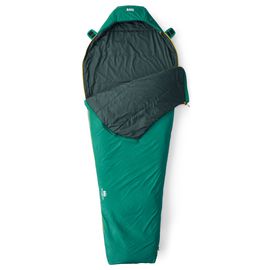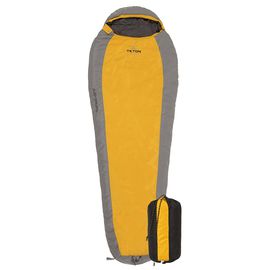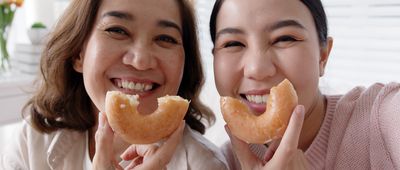Best Sleeping Bags
Whether you're camping in the backwoods or sending a kid to a sleepover, a comfortable sleeping bag is essential for a sound night's sleep. Prices range from about $20 for a cheap sleeping bag suitable for a backyard slumber party to $800 or more for the kind professional mountaineers use. When you factor in purpose, quality, and budget, your options begin to narrow. That said, there are good cheap sleeping bags to be had, and Cheapism.com has compiled the best in this guide.
Our Top Pick


Teton Sports Tracker Review
Best Winter Sleeping Bag Under $100
Pros:
- Extra layer of insulation keeps the foot box warm and toasty, reviewers say.
- Lifetime limited warranty.
- Easy to store compactly, owners say.
- Zippered interior pocket.
Cons:
- Manufacturer-rated to 5 degrees, but many campers say it's comfortable only to about 20 degrees.
- Like other mummy bags, this model feels confining to some tall or heavy people.
- Zippers are prone to malfunctioning, reviewers say.
Takeaway: Most owners say the Teton Sports Tracker is comfortable and very easy to roll up and pack in its water-resistant stuff sack. At 4.1 pounds, it's too heavy for backpacking but ideal for car camping. Reviewers praise features like the three-piece hood, which keeps the head elevated off the cold ground, and the zippered interior pocket for stashing personal items. Many owners say they like the long interior and exterior zipper pulls. They're less than thrilled that the sleeping bag zips up on the left side rather than the right. The biggest drawback, according to owners, is that the sleeping bag doesn't live up to Teton's comfort rating, a complaint common to cheap cold-weather sleeping bags.

Teton Sports Celsius Regular Review
Best Winter Sleeping Bag Under $50
Pros:
- Very comfortable, flannel-like interior lining, according to reviews.
- Temperature rating of 0 degrees Fahrenheit.
- Lifetime limited warranty.
Cons:
- Doesn't stay warm in sub-freezing temperatures, some reviewers complain.
- Some campers who are over 6 feet tall say this sleeping bag doesn't feel long enough, although it measures 80 inches.
- Weighs 5 pounds, too heavy for backpacking.
Takeaway: Most owners are satisfied with this three-season sleeping bag and say it delivers good value for the price. Owners praise details like the built-in loops at the base, so the sleeping bag can hang upright for storage, and the choice of a left- or right-hand zipper. However, we also found a number of complaints from people who say the bag tends to unzip as they toss and turn during the night. A handful of reviewers say that although this bag is comfortable to about 30 degrees, it doesn't keep them warm enough in colder weather, despite the manufacturer's 0-degree comfort rating.

Kelty Tuck 20 Degree Review
Best 3-Season Sleeping Bag Under $100
Pros:
- Available in two sizes to accommodate people up to 6-foot-6.
- Foot box can be unzipped if your feet get too warm.
- Comfortable, even for taller users, according to reviews.
Cons:
- Can be challenging to pack into its stuff sack, some owners say.
- Scattered complaints that the bag doesn't stay very warm at colder temperatures.
- Weighs just 3 pounds, but some reviewers complain that it feels much heavier.
Takeaway: Three-season mummy bags can cost $200 or $300, but this Kelty bag is nearly as good and much cheaper. Most owners say this sleeping bag is very comfortable, something borne out by the relative lack of complaints about it feeling cramped or too snug (something that can't be said about all mummy bags). Despite generally positive comments from professional and consumer reviewers alike, a few users report that the bag didn't keep them warm enough when the mercury dipped below freezing, even though it is rated to 20 degrees.

Coleman Brazos Cold Weather Review
Best 3-Season Sleeping Bag Under $50
Pros:
- Very low price.
- Rectangular bag can be unzipped and connected to a second sleeping bag to make a double size.
- Good choice for car camping or slumber parties, owners say.
Cons:
- Doesn't stay warm in the coldest temperatures promised by its 20-degree rating, owners say.
- Warranty is only 5 years, shorter than other brands.
- Not designed for campers over 5-foot-11.
Takeaway: This three-season, rectangular Coleman sleeping bag is very roomy, but that bulk also makes it too hefty to pack easily or take on a hike — something a number of owners note in their reviews. Several consumers also complain that the polyester lining feels cheap and uncomfortable, while others say the zipper breaks easily. But for most owners, this bargain-priced sleeping bag is a terrific companion for car camping, kids' sleepovers, and nights when you need an extra blanket on the bed.

Rei Co-op Helio Sack 55 Review
Best Summer Sleeping Bag
Pros:
- Weighs just over a pound.
- Available in two lengths (72 and 78 inches), plus an extra-wide model.
- Lifetime warranty.
Cons:
- May feel confining to some big and tall campers.
- Limited temperature range; not designed for cold weather.
Takeaway: Weighing just 1.1 pounds, this REI mummy bag is a good choice for people who tend to camp and hike only in warm weather. It fully unzips for use as a blanket, and there's a second zipper on the side that can be used as an air vent or armhole, an unusual detail that reviewers like. The bag packs and compresses just as easily, owners say. Keep in mind, this bag is rated only to 55 degrees Fahrenheit, so it's not a good choice for cooler climates or seasons. Unlike most REI sleeping bags, this model has relatively few customer reviews online. But the previous version of the same sleeping bag (which differed only in color) got stellar user reviews and recommendations from professionals, so expect the updated Helio Sack 55 to be an excellent option for summertime camping.

Coleman North Rim Extreme Weather Review
Good Winter Sleeping Bag
Pros:
- Rated to 0 degrees Fahrenheit and keeps users warm and cozy.
- Relatively low price for a four-season sleeping bag.
- Can be fully unzipped and used as a comforter.
Cons:
- Zipper is prone to breaking, many reviewers say.
- Weighs 5.8 pounds, too heavy for backpacking.
- Height limit of 6-foot-2, but some adults over 6 feet find it too snug.
Takeaway: Coleman has been making camping and outdoor gear for more than a century, so it's little surprise that its four-season North Rim sleeping bag gets largely positive reviews from consumers. Owners consistently praise this mummy bag for its warmth and comfort in a variety of weather conditions. But some of those same reviewers also complain about durability, most notably the zipper and the stitching on the polyester ripstop fabric. This Coleman sleeping bag does come with a five-year limited warranty, although other manufacturers like Teton and REI offer longer guarantees.

Teton Sports Trailhead Review
Good 3-Season Sleeping Bag
Pros:
- Weighs 2.9 pounds, just light enough for backpacking.
- Zippered interior pocket is handy for stashing personal items.
- 87 inches long; accommodates users over 6 feet tall.
- Comfortable brushed polyester lining.
- Lifetime limited warranty.
Cons:
- Doesn't stay warm in sub-freezing temperatures, some reviewers complain.
- Big and tall users say this mummy bag is too snug at the shoulders and chest.
- Can be difficult to zip up all the way once you're in, owners say.
Takeaway: This three-season Teton sleeping bag is lightweight and fairly easy to pack into its stuff sack, reviewers say, making it a good choice for backpackers or car campers who want to toss it into the trunk and go. It's also available in a shorter (and cheaper) 75-inch size. Reviewers say this sleeping bag is well-constructed, with a waterproof rip-stop polyester shell and zipper pulls that are easy to handle. The most common complaint is that the manufacturer's 20-degree temperature rating is overly optimistic. Campers who are heavy or taller than 6 feet also may find this sleeping bag too confining, a common complaint about mummy bags in general. Despite these gripes, most users say this is a good sleeping bag for a weekend camping trip.




















